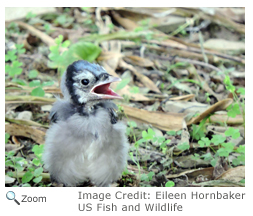Diet

The blue jay is
omnivorous. It eats fruits, acorns, seeds, nuts, insects, mice and frogs. Sometimes a blue jay will raid a nest for eggs and young birds. When a blue jay eats nuts, it holds the nut with its feet and cracks it open with its bill. The blue jay is a seed spreader. It often buries food to eat later. Some seeds and nuts are never recovered and grow into trees and other plants!
Life Cycle

The female blue jay lays four to six eggs in a nest made of sticks and twigs and lined with grass. Nests are made in trees and shrubs. The female incubates the eggs, although sometimes the male will help. The eggs incubate for about 17 days. Both parents bring the chicks food.
Behavior
The blue jay is very aggressive and territorial. Groups of blue jays often attack intruders and predators. They often drive other birds away from bird feeders. The blue jay is also very vocal. It makes a number of different calls including its distinctive "
jay- jay." It also growls, whistles and chatters.